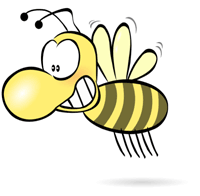 What really held my attention though were the bees! The camera went inside a hive. Looking with the natural lens it appeared that some of the bees were sitting around not really pulling their weight while other bees were very busy bees. I am familiar with groups of people – some apparently not pulling their weight, while others are firing on all cylinders. Switch to infra red and the busy bees turn black, and the lazy bees turn yellow. The sitting-around bees were hot little bees and the busy bees were cold bees. The hot little bees were so hot that just a few degrees hotter and they would have probably burst into flame! They were sitting around doing something important because they were generating heat and keeping the baby bees not yet hatched warm. The busy bees were feeding honey to the sitting around bees – the honey being converted to energy to keep them hot.
What really held my attention though were the bees! The camera went inside a hive. Looking with the natural lens it appeared that some of the bees were sitting around not really pulling their weight while other bees were very busy bees. I am familiar with groups of people – some apparently not pulling their weight, while others are firing on all cylinders. Switch to infra red and the busy bees turn black, and the lazy bees turn yellow. The sitting-around bees were hot little bees and the busy bees were cold bees. The hot little bees were so hot that just a few degrees hotter and they would have probably burst into flame! They were sitting around doing something important because they were generating heat and keeping the baby bees not yet hatched warm. The busy bees were feeding honey to the sitting around bees – the honey being converted to energy to keep them hot. The temperature at which the baby bees not quite hatched were kept at determined what kind of bees they would turn out to be. A slightly lower temperature would produce a busy little worker bee who rarely left the nest. These little fellows fed the hot bees and generally kept the hive clean. They didn’t have long life spans.
However, a slightly higher temperature produced a forager bee. These little fellows were the ones flying from flower to flower collecting nectar and telling other bees where the food sources were. They were stronger bees, living up to ten years.
Whether it was a worker bee or a forager bee was all down to the temperature that the hot bee kept the baby bees not yet hatched.
I have been reading the early chapters of Ezra. The Jewish nation had been granted permission to leave Babylon and return to Jerusalem. Some of them decided to stay put in Babylon, they had put down roots and were reluctant to move. Others were already packed and waiting to leave. When they got there they built the altar and made lots of sacrifices, but when it came to rebuilding the temple – it was a much bigger job and they encountered opposition. They were discouraged enough to stop working. Years later, the prophets Haggai and Zechariah were called in to bring a word from God. It was very stirring stuff.
Haggai’s word was in the form of a rebuke, chastising them for neglecting to build the temple. They were busy redecorating their own homes, adding fitted kitchens and conservatories, and God’s house was still in ruins. Haggai pointed out that the drought they were living in was linked to their neglect of God’s house. No matter how much they planted, they never harvested a bumper crop. They never had an abundance of stuff.
Haggai’s word hit the mark with me. Although I have my moments of revelation, for much of the time the word “drought” fits. I have been discouraged and downhearted of late. It has been a dry time and I have had to dig some deep wells to get to water! I just thought it was one of those dry times that we all go through. Seeing it through Haggai’s eyes, linking it into building, or neglecting to build, God’s house, has shown up my dryness in a different light.
I got to thinking about the hot bees. When the hot bees cool down, the offspring, the fruit of the hive, is made up of busy, short life worker bees that don’t really go anywhere. When the hot bees stay hot, the bees that get born are stronger bees, living a long time, going on exciting journeys, feeding the hive, helping it to remain vibrant.
If the Jews listening to Haggai had been bees in a bee hive, before he spoke they would have been the black bees seen through the infra red lens. Busy perhaps, but producing something that lasted for just a short time, something that never really went anywhere. The leaders were convicted by Haggai’s word and began to work on the temple. Under the infra red lens they would be like the hot bees, producing the forager bees, the strong ones that lived for years.
I am meant to be a hot bee. Somewhere along the line I have cooled down. The fruit in my life is not as strong, not as vibrant, not really contributing to the body in the way it should be. How do I get to be hot again? One of the ways in which the word describes itself is “honey”. Just as the hot bees needed to be fed honey to maintain their heat – I need to feed on the word. Whether that is “preached” word, “sung” word, “read” word, “prophesied” word or “dreamed” word matters not.
Amazing what lessons the natural world can teach us – even the bits we can’t see.
No comments:
Post a Comment